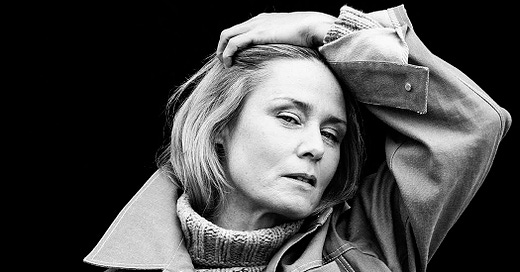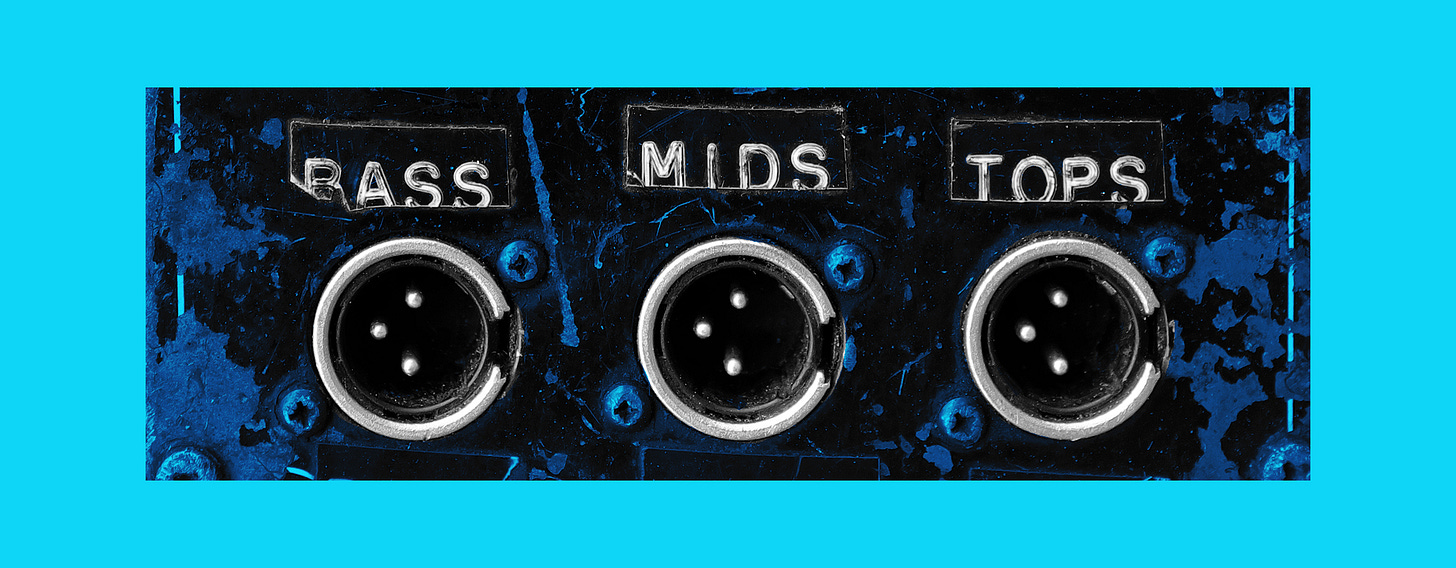So we’re underway.
Hope you liked the Fabio & Grooverider interview. They made us laugh a lot, and so did the next interviewee.
I’d fleetingly crossed paths with Róisín Murphy couple of times over the years she was in Moloko with Mark Brydon, though at this point very much as a fan. I think the first time I spoke to her was a brief hello when I was DJing at my friends Freekin’ the Frame night at The End1 in 1999 – particularly memorable for her jumping on stage with Jamie Lidell for an improvised version of Talking Heads “Once in a Lifetime.” At some point in the early 00s, Murphy’s fashion icon status was confirmed when my wife was so excited to see her in attendance at a Sunday Best party at Rockwell Lido she dove under a table to see what shoes she was wearing.
I absolutely devoured her solo records in the 00s: Ruby Blue with Matthew Herbert in 2005 provided multiple anthems for the Southeast London pub lock-in sessions I DJed (dancing on tables to “Ramalama (Bang Bang)” is an unsurpassable joy), and the 2007 Overpowered era included some particularly memorable live sets at the Scala and The Big Chill. Even when she took an extended break post-Overpowered, mainly to concentrate on parenthood, every so often she’d provide a little reminder of what she was capable of, most notably with the one-off single “Simulation” in 2012 with old Sheffield compadre DJ Parrot aka Crooked Man which gave me a particularly magic memory as I was able to drop it at sunset in the courtyard of the Croatian fortress hosting Dimensions festival.
But the first time I met her properly was for this interview for FACT on the occasion of her comeback in 2014 (if you’re a fan of continuity, there’s a particular point in this interview at which you should read it to fill in a gap: look out for the signal). Since then we’ve worked together on a number of things – I’ve written biogs for her, she’s disrupted my ambient salon – and interacted a lot on “the socials”, generally in good humour, sometimes crossing swords… because Róisín is the very definition of formidable. She is always powered along by the absolutely furious, sometimes perverse, but always totally focused drive that has made all her collaborations, records, performances, fashion and art direction, interviews and the rest hold together as one huge ever-growing pulsating exploding day-glo Gesamtkunstwerk.
In the nine years since that comeback, she’s dropped an Italian language mini-album, the deeply peculiar one-two punch of Hairless Toys and Take Her up to Monto with former her Moloko bandmate and long-term musical director Eddie Stevens, an album’s worth of wonky 80s-flavoured club tracks over a set of EPs with Baltimore-via Sheffield maverick Maurice Fulton, the devastating disco of the deservedly top 5 charting Róisín Machine with Crooked Man joining the dots back to “Simulation” (he then remade the album as Crooked Machine), and – just coming up – another humdinger of an album in Hit Parade on Ninja Tune with the hallucinogenic Hamburger and latterly martial artist DJ Koze producing.
It’s a lot. SHE is a lot. In a world where pop music stardom is reduced, transactional, cynical, she’s a star of the old school, larger than life and completely committed to the bit in everything she does. Regardless of how well given records may do, she’s a raging success on her own terms and really by any rational standards, still living large in the Balearics, self-managed, self-directed, still in touch with the dancefloor and club culture, with a fiercely loyal fanbase and endless demand for her performances. (If you haven’t seen it, try and track down the recording of her Glastonbury set from 2022 to see just what those performances are about: it’s a masterclass in stagecraft, show design and crowd relationship from someone at the height of their powers.)
Brian took these pictures in London, and I did the interview on Zoom as she wandered around her house in Ibiza trying to avoid interruptions but keep her wifi signal. The interview that follows contains the phrase “Oh, me leg's come off!”, and repeated insights into how she’s powered through the years on the basis of people saying “I don’t know what she is, but she's something.”
There she is. She SEES you.
Shall we go right back to the beginning?
Róisín Murphy: Yes.
OK. Where did you grow up?
I grew up in Arklow, small town just down the coast from Dublin. About an hour of a drive.
And were you around music early on?
I was, yeah, very much so. Around a lot of live music, mainly. Although me mother had a record collection and she would play records into the night on her own sometimes, and you'd wake up to a lot of scratched, fucked up records.... but she definitely had a record collection. But mainly, it was live music I was around. My uncle was a fantastic musician. He is called Jim Tyrrell, and he had many kind of show bands originally in the sixties, and then he had jazz bands. He had a five-piece and a three-piece, and he was always the band leader and he played every single instrument that you could imagine. He was pitch perfect, which is an unusual thing to be. And he's fucking genius. An amazing singer as well. My mum's family, there – that's her sister's husband. So, that was the centre of their social scene really, that music, that gang of musicians. They'd play every Sunday when I was a child in a place called Gardeners. We had to drive out to it. It was about a half an hour's drive from Arklow into the country, even smaller town called Coolgreany. Coolgreany, C-O-O-L, Coolgreany, and we used to go there every Sunday for all-day jazz sessions when I was a kid, really small. I can't remember the first time I heard a band fully on the stage. I just always have heard them and saw them and been part of it and been part of their gang, you know? So I guess I was subconsciously kind of brought up to be what I am, even though I had no idea that was what it was going to be. All that stuff went in, the cultural part of it especially.
Right, culture in the literal, sense, as in people doing it together.
Yes, absolutely. And always been around music and song and singing, and that's what held it together. That was the cohesion of the whole culture of my family's friend group and family group. They never stopped singing. They were all singers. Do ten or a hundred songs...
What about music that you felt was yours? Can you remember what the first thing that either kind of you felt you'd discovered or that belonged to you in your friend group rather than the family?
Well, I was really into Top of the Pops as a kid, and I was always really good at predicting what was going to be number one. So I'd say that was a nice game. I suppose lots of people played it. “That's going to be number one now. Hundred percent.” So, I was always really into pop music. Madonna came along, of course. How old would I have been? 10, something like that. And we'd be roaming the streets, gangs of girls roaming the streets singing “Like A Virgin” when we actually all were virgins. It was quite ironic. But we were like virgins. Yeah, she was a bit of a moment, I think, for me as a kid. Hundred percent. But then that came out of... my brother was a huge fan of Blondie, so he had all their records and he had the poster on the wall, and this is even younger, you know? And the poster on the wall was Debbie Harry wearing the Warhol T-shirt. And that - it had so many symbols in that one image that would be something that I would discover later on in life, you know? Andy Warhol, that whole kind of underground culture, punk kind of attitude and glam rock and sort of everything was distilled in that one image I think, really. And I used to stare and stare and stare and stare at it.
Keep reading with a 7-day free trial
Subscribe to Bass, Mids, Tops and the Rest to keep reading this post and get 7 days of free access to the full post archives.





